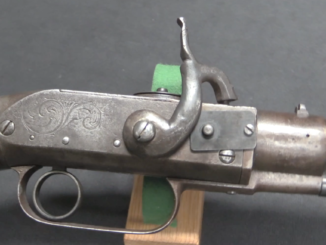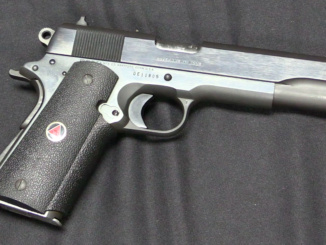Saddle Ring Carbine
Deluxe Rifle
The Model 1886 was the first Winchester repeating rifle to improve on the original toggle locking system of the 1860 Henry, and it is also the first of John Moses Browning’s lever action designs. Browning met with Winchester executives to sell them his design for the Winchester 1885 single shot rifle, and mentioned that he was also working on a lever action repeating rifle that would be much stronger than the existing Model 1876. This was very interesting to Winchester, and they agreed to buy that design as well.
The new rifle used a pair of vertically sliding blocks to lock the bolt into the receiver upon firing, and allowed the weapon to safely chamber much more powerful rounds, up to and including the .50-100 Express. This rifle superseded the Model 1876 almost overnight, as it finally allowed a single rifle to have the power of the single shot buffalo rifles and the rapid firepower of the smaller caliber Winchesters.




$50,000 in 1886 in approximately $1.2 million today!
http://www.in2013dollars.com/1886-dollars-in-2015?amount=50000
At least!
A dollar was defined at 1/20 of an ounce of gold
The dollar has depreciated to approximately 1/1,200 or less of an ounce of gold.
At 1/1,200th of an ounce, it puts the present day paper dollar price at $3,000,000
Thank you Ian for the excellent coverage of this fantastic lever action rifle. Whether the general population is aware, this is nearly the epitome of the American levergun.
Even though not technically a 1886, I got to shoot a long time Alaskan residents model 71, with some of his “bear loads” and they were real handfuls. Which brings up another point, these were, to me, heavier rifles than the 1876, in the samples I’ve handled and much heavier than later Winchester lever actions, which I”m sure you’ll get too. Which one exception.
I did own for a a time a modern reproduction marketed by the Browning corporation made in Japan, by I believe the Miroku (sp) company, (it’s been a few years) and idue to new metallurgy, was capable of even more fearsome loads.
One thing that the modern shooter doesn’t like is the issue of mounting a scope – IMO, that was one issue that killed the model 71, in addition to being a very expensive rifle to produce. I wonder with new optics, it might be different, but I feel the majority of the American shooter doesn’t have a desire to shoot very heavy bullets at what are considered slow or moderate velocities from a rifle that isn’t a “modern sporting rifle”
One question Ian, as part of this series are you planning to cover the 1895 again, as you covered it some years previously..
Once again, thanks for the video and the information.
“modern shooter doesn’t like is the issue of mounting a scope – IMO, that was one issue that killed the model 71, in addition to being a very expensive rifle to produce”
How it is with availability of:
-.348 Winchester cartridges
-.348 bullets
?
Wouldn’t it attract more hand-loader, if it would .358 (like .35 Remington)?
Does anybody known why Winchester chose .348″ in first place? If I am not mistaken, when it was introduced (1936) others cartridges with such bullet diameters did not exist commercially – Winchester earlier created .33 Winchester cartridge, which use .338″, why they chose to switch to another bullet diameter?
“scope”
Can’t be scope mount off-set to side to avoid problems? Also, I am not sure whatever scope would be very useful, considering ballistic of .348 Winchester cartridge.
People have side-mounted scopes on lever rifles like this. But that defeats the advantage of a rifle with nothing sticking out of the sides of it that is easy to carry in a scabbard while on horse back. Easy to carry on foot too, nothing to snag on vines or other entanglements.
The Marlin lever actions eject out the side and come drilled and taped for scope mounts. Probably why Marlin overtook Winchester in lever guns.
But yes, not much point really in putting a scope on a rifle that only shoots round nose bullets for most shooters. That did not become an issue until the market shifted from people who used a rifle in their daily work to once a year deer hunters.
Probably the best solution for scoping a top-eject levergun is a long-eye-relief scope mounted out on the barrel in the manner of some of the German sniper rifles of WW2. With a scope with a suitably large pickup area for your eye, it can be used for snap shots as well as deliberate aiming.
And yes, this was the basis for Col. Jeff Cooper’s Scout Rifle concept. In fact, his first experiments were with a Winchester M1894 .30-30 with a Bushnell Phantom pistol scope mounted in place of the buckhorn rear sight.
Actually, such a setup on a .30-30 M’94 would take care of probably 95% of hunting and even defensive rifle work for most people, even today.
cheers
eon
“That did not become an issue until the market shifted from people who used a rifle in their daily work to once a year deer hunters.”
Considering that, would REFLEX sights be solution? It can be mounted forward of ejection port, with less sticking that off-set scope.
If you don’t mind a rather Star Trek looking thing on top of your lever action, a LER red dot sight would certainly be a good option.
Another would be the older Aimpoint type, like the Patrol Rifle Sight or the Bushnell TRS-25.
All of the above are intended mainly for fast snap-shooting at close range, which is what the lever gun does better than almost any other manual repeating long arm, with the possible exception of the pump action.
cheers
eon
The.348 has spawned a very good wildcat. The .450 Alaskan. I think A square may have produced some factory loads for it.
It is very close to the claimed performance of the .458 win mag. The actual performance of the .458 win has left much to be desired. So honest hand loads in the .450 Alaskan might be ahead of the 458.
Disappointment at the field performance of the .458 win (it has an attrocious reputation for failure to penetrate) has lead to a number of larger capacity cases, for example the late Jack Lott’s .458 Lott, which will also safely handle .458 win.
Commonly available.358 rifle bullets are ok for deer and elk sized animals. They tend to lack the sectional density and jacket thickness to be adequate on larger animals.
9.3mm (.365″) bullets, that do have the required attributes, are widely available https://www.bullet-behavior.com/9-3×62-or-35-whelen
Winchester used to offer a very nice bolt mounted aperture sight. I think that some of the Browning miroku production also had that sight.
“.450 Alaskan”
.348 Winchester also spawned .50 Alaskan:
https://en.wikipedia.org/wiki/.50_Alaskan
thus more-or-less evolving in reverse direction (.348 Winchester itself was spawned by .50-110 Winchester)
I have one of the reproduction ’86’s that Winchester made in the late 1990’s, very high quality, and in 45-70. It’s a blast to shoot. Of all the lever actions Winchester made the ’86 is my hands down favorite. It was a good looking rifle when it first came out, and still is to this day.
“was a good looking rifle when it first came out”
From Winchester lever-action repeaters, I am more fond of Winchester Model 71 aesthetic-wise.
“weapon to safely chamber much more powerful rounds, up to and including the .50-100 Express”
Assuming that identical steel would be used for both, which one would have more strength: Winchester Model 1886 or Marlin Model 1881:
http://www.imfdb.org/wiki/Marlin_Model_1881
I guess it depends on how the receiver assembly deals with firing stress. Similarly, there is a good reason why kitchen knives lacking full tangs perform poorly when cutting into something tougher than gelatin. Trust me, my mother bought a stainless steel bread knife made with a hollow rubber handle over ten years ago. The handle came off when she tried to cut her homemade wheat bread. Turns out the blade didn’t have an actual tang and was GLUED to the rubber handle! Mom was furious!
I bought one of those trendy “knife block sets” for about $45 (on sale) at the local “kitchen notions” place when I moved to my new house 15 years ago. I was rather surprised to find that the blades, which do have full tangs, would literally slide out of the high-durometer neoprene hilts after one or two cycles through the dishwasher.
Five minute epoxy took care of that. I’m sure the postmodern, metrosexual, toney loft types would be absolutely horrified at the very thought.
But hey, I’m not using my Gerber MK II or Buck Nighthawk to bone a chicken with. (Not in the kitchen, anyway.)
cheers
eon
Browning’s single-shot design had several notable qualities devolved from his years of shooting to eat, and his years repairing guns at his father’s elbow: it was simple, durable, a fairly easy manufacturing proposition, and it was smooth to operate, along with having fine balance and innate accuracy.
Thus when Browning turned his attention to improving Winchester’s product, he not only made it stronger, he made it safer and smoother. Years later, when Browning and Winchester broke, the president of Winchester spent much ink minimizing Browning’s contributions to the gun, which far exceeded that of merely adding a stronger lock to the toggle-link.
Incidentally, I opine that Browning cribbed the vertical locking bars from the Spencer. I think the reasons Spencer got real military contracts was the much stronger lock (a vertical post locking into the top of the receiver), and the completely enclosed magazine and action. The negative reasons vs. the Henry were the smaller magazine and the slower rate of fire — mustn’t waste that expensive fixed cartridge ammunition!
I recommend to all who read here the book “John M. Browning, American Gunmaker,” by his son John Browning with Curt Gentry. It is a little too uncritical of JMB as an inventor and personality, and not well-organized (not chronological), but the stories recounted are very interesting and there is appended a useful list of all of JMB’s patents with various production records.
“(…)book “John M. Browning, American Gunmaker,”(…)”
Does it explain why J.M.Browning was such low active in development of bolt-action rifles? If I am not mistaken his only produced bolt-action was Winchester Model 1900: http://www.historicalfirearms.info/post/96202651653/cutaway-of-the-day-winchester-model-1900-the/embed
which is single-shot for .22 rim-fire cartridge. Why he did not developed full-size bolt-action repeating rifle, which might be successfully exported in late 19th/early 20th century?
I think this Winchester/lever action series retrospective is great stuff.
Maybe that stuff is old news to people of my fathers generation, not ‘Forgotten Weapons’ to them, but it’s all new to me.
And as usual, Ian does a fine job of presenting the information in an interesting and detailed way.
My enjoyment of Forgotten Weapons videos almost makes me forget my envy of Ian!
I would like to see the Browning designs that Winchester never produced.
What kind of wizardry was withheld from us?
“wizardry”
I think, some data might be gathered from U.S. Patents
https://www.google.com/search?tbo=p&tbm=pts&hl=en&q=ininventor:%22John+M+Browning%22
All of the patents are available on the USPTO site. There are also a couple of sites which list his patents with descriptions of some of them.
David,
Here you go, have fun! ^__^:
http://armspost.com/john-browning/
Many of the patent ideas that were not produced did get tool-room prototypes made, and many of those survive at the Cody Firearms Museum.
Dear sir: You can obtain the book mentioned above, which has photographs of all the prototypes, or you can refer to the post above, and view the patents via the links therein. Among the unproduced weapons was a .22 rifle in which trigger, firing pin, and breechblock were all one piece; a lever-action gun in which the entire breechblock swung out the bottom of the frame; any number of slide-action rifles and shotguns, a number of pull-open or pull-forward long arms, and the rotating-bolt and gas-operated pistols referenced on this site.
One correction: The firing pin is not held back by the coil-spring plunger ejector. There is a cam on the end of the lever that operates the bolt, and a matching notch in the firing pin, that positively cams the firing pin back from the breech face when you open the action. When fitted properly, it prevents the firing pin from protruding from the breech face until the locking blocks have engaged with the recesses in the bolt.
One of the other, major improvements to the Henry design is the positive cartridge stop that allows cartridges of different lengths to feed through the action and not jam the gun. The Henry/1866/1873/1876 can be jammed up solid by cartridges that are not the proper length, either too short or too long. Most of the Henry design guns that you find with broken lifters are due to someone trying to forcibly clear a jam and breaking the lifting mechanism.
Browning continued to use positive cartridge stops well into the twentieth century
Even in designs which superficially would have worked ok without,. An example would be the bottom ejecting semi auto .22 rifle (us pat 1,083,384) which employs a bolt operated cartridge stop in the feed from the tube magazine in the stock.
It was attention to detail, even when that added complexity and expense to manufacture, that was one of the areas where Browning differed from the generic engineers who followed him in the big manufacturers.
JMB said: “If something can go wrong with a gun, it will.” Many of his design details, based on long experience repairing other men’s designs, went toward minimizing things that might go wrong.
Of course he made his own errors. The 1887 pump shotgun needed an extra lock on it (designed by Winchester’s in-house engineer); the BAR, if over-oiled, started jamming (not corrected until the Korean war by the addition of nylon materials); even the brilliant A5 shotgun was a tad awkward to load (hold bolt release button down with one hand while shoving cartridges in with the other) until the posthumous addition by FN engineers of a folding cartridge lifter.
Nevertheless, when he and his collaborators at Colt or FN got things right, they stayed right. Examples: a century of the 1911, eighty years of the P35; and the M1917 machine gun, variants of which armed every allied aircraft of WWII and arguably saved democracy.